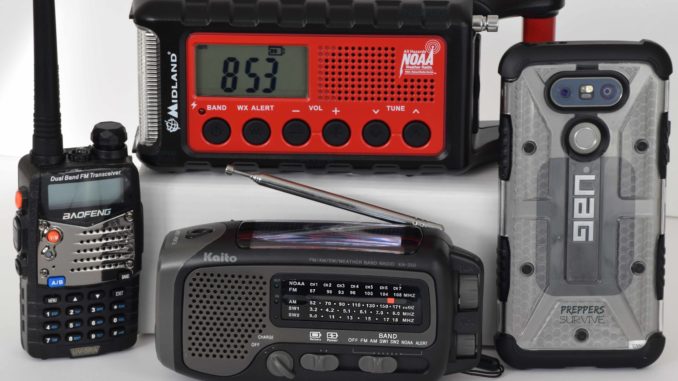
It was time… time to update my analog radio to a digital preparedness radio. What is a preparedness radio? A preparedness radio is a radio that gets the National Oceanic and Atmospheric (NOAA) stations also known as emergency weather stations. It also should have multiple power source options. Preparedness radios also come with a variety of other features. Below is a list of features that I look for an in good preparedness radio. You’ll also find a comparison of a basic and loaded preparedness radio. Lastly, in this article is a little information about NOAA weather band radio stations.
What Makes a Good Preparedness Radio?
Ok, so I had a perfectly good preparedness radio. The truth is that I wanted a second radio just in case the first one broke. My first radio is a Kaito Voyager Trek. It’s a compact radio perfect for an emergency kit. It has the basic preparedness radio features:
- Gets NOAA, FM, and AM stations
- Alert capabilities
- Hand crank, solar, battery, and USB powered options
- Flashlight
- Earbud jack for private listening
The Kaito Voyager Trek is a good radio but there were a few upgrades I wanted. Having a basic radio wasn’t working for me. I wanted the best emergency radio to add to my preparedness supplies. Below are the four upgrades I wanted.
- Digital radio – It’s easier to locate a radio station when you can read the exact station you are on. Digital radios also have advanced tech that tends to get better reception than analog radios.
- Memory settings – I don’t want to search for radio stations in an emergency. I’d rather flip quickly between news channels.
- At least a 2000 mAh rechargeable battery – This allows me to charge my smartphone using the radio. Most smartphones are 2000 – 3000 mAh.
- Signaling for help – I go on hiking trips on occasion. It would be helpful to have features that signal for help if I get lost.
- Battery life indicator – It’s helpful to know when the battery is nearing empty so I can conserve battery life or recharge it.
Comparison: Midland ER310 & Kaito Voyager Trek
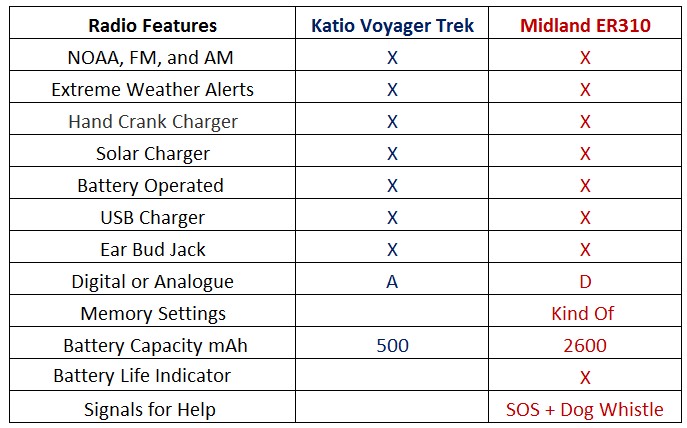
As you can see from the pictures I purchased the Midland ER310 for the upgrades that I wanted. It’s nice to see the digital frequency so I know I’m on the right station. This Midland doesn’t technically have a memory settings feature. However, there is one button that switches quickly between NOAA, FM, and AM. As long as the battery doesn’t die, it will stay on the last station I was on in each of the three bands. For example, I can toggle between three set stations of my choosing as long as they are on the three different bands (NOAA 162.550, FM 101.1, AM 590). These are news radio stations that I found on Radio Locator. There’s a battery life indicator to know when to recharge the battery. It’s most unique feature is the dog whistle that can help search and rescue teams locate you. The flashlight has multiple settings one of which flashes SOS.
Frugal Preparedness Radio
There are NOAA weather apps and local news apps that are free to download on smartphones. Some of these apps provide weather warnings. Please note that internet and cell service might be interrupted during extreme weather so a radio is best. These apps can be a helpful addition to your emergency preps or a way to get started.
NOAA Active Weather Alerts
What is NOAA weather radio? It’s a radio that can tune-in to at least one of the seven NOAA radio stations. Just flip through the seven channels to see which is the stronger signal in your area. When you get a clear signal you’ll hear a recorded voice listing the weather forecast and temperature in your county and surrounding areas. It also broadcasts the date and time. Newer preparedness radios can be programmed to alert you if extreme weather is headed for your door.
Turning on the NOAA alert on is fairly simple on these two models. First, find the NOAA frequency that works in your area by scrolling through the seven channels until you hear the weather. Next, on the analog radio, you’ll switch the button from FM or NOAA to ALERT. On the digital radio, you’ll just push the WX ALERT button until you see WX come up on the screen. The weather station tests the alert system so you may not have long to wait (a week or so) until the alert goes off.
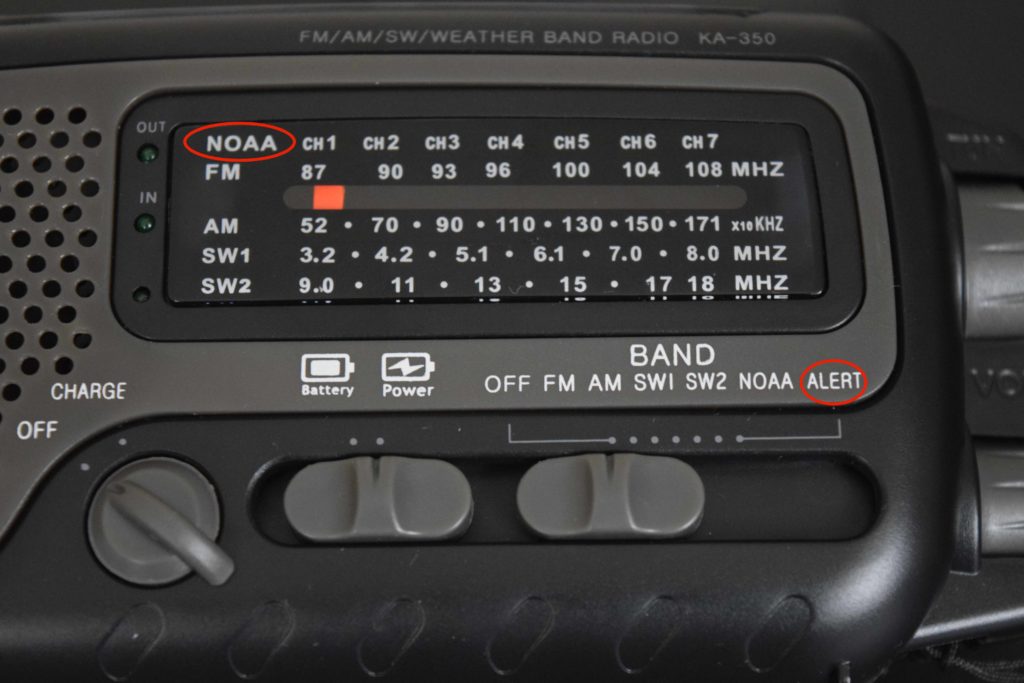
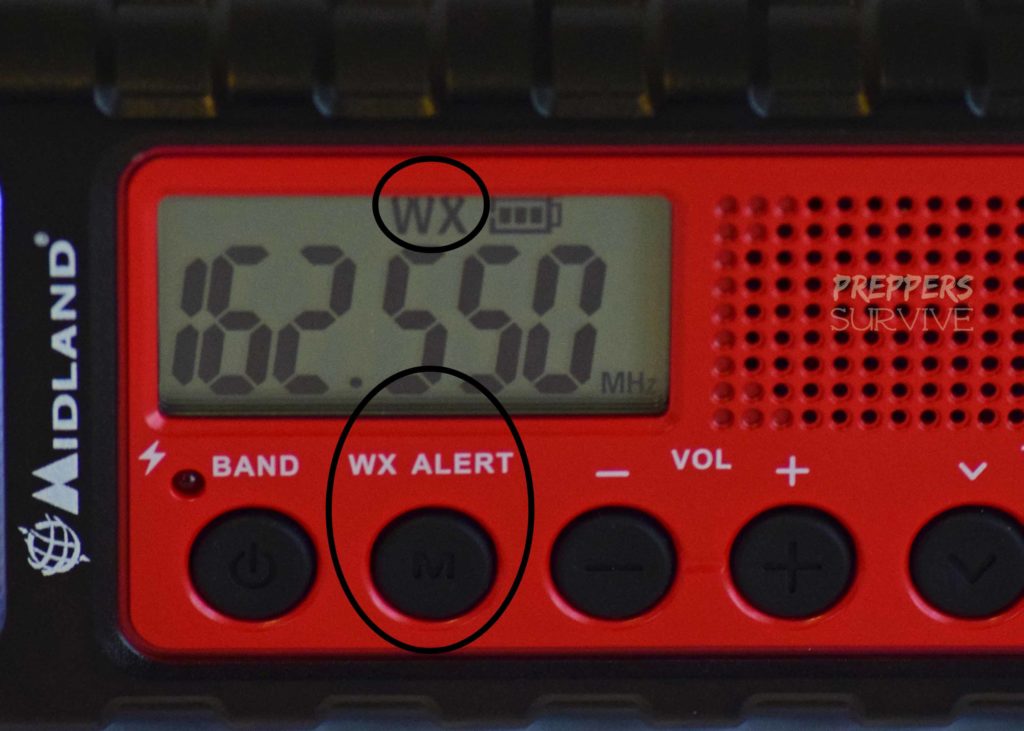
NOAA Active Alert Maps:
The seven NOAA radio stations:
- 162.400
- 162.425
- 162.450
- 162.475
- 162.500
- 162.525
- 162.550
Note: Ham radios can get NOAA channels with channels ranging from 136-174. They also have memory settings.
Thanks for visiting Preppers Survive. Before you leave subscribe to our newsletter. If you enjoyed this article, please share it on your favorite social media.


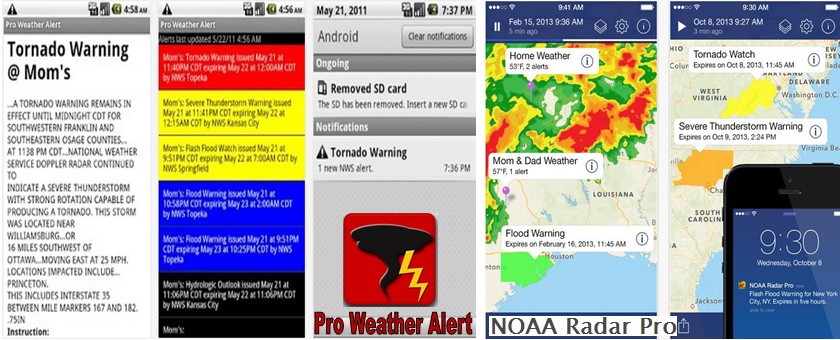
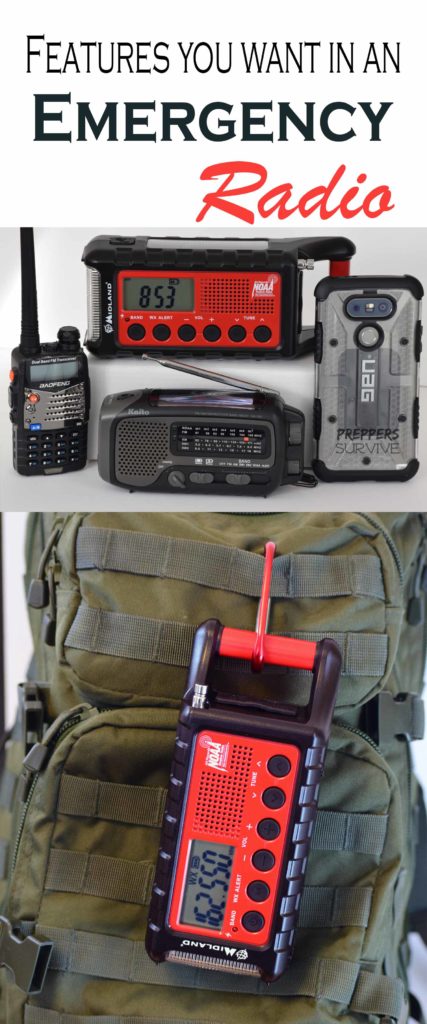
We really should include amateur (ham) radio in our preps. The walkie talkies sold everywhere claiming 35 mile use are blowing smoke. You would not reliably get more than a half mile out of them. Try now to see for yourself. Ham radio is not difficult. It will cost $15 to take the license test. For those who say you won’t need a license when the shit hits the fan, right you are, but you WILL need one to start practicing and using your radio now. And, yes, you do need to get some practice and experience before you are in an emergency situation. An added benefit will be the people you meet through ham radio. At the very least, find an amateur radio club in your area and go to a meeting or swap-meet.
I agree. Ham radios are so affordable now every prepper should have one. You don’t need a license to listen in.
It’s also not hard to get an amateur radio license and a ham license will open up a lot of possibilities. In the meantime, I recommend that people get a quality, commercial-grade GMRS/MURS/NOAA radio like the TERAs that I sell, not crappy Baofeng radios or bubble-pack radios, which are basically disposable. 🙂
Not only is it easy to get the beginning amateur radio Tech license (and get access to more than 22,000 repeaters within the U.S. alone), preppers now have much more selection (at various price points) than simple el-cheapo FRS radios, then poorly made (but still cheap) Baofeng radio products, and then all the way to expensive Kenwood, Icom, or Yaesu products.
We sell many different brands of radios, but one of our most popular prepper radios is the TYT TH-UV8000D V4 radio. Not only does it offer 10 watts of power on both VHF and UHF frequencies (vs. 4-5 watts with a Baofeng), it comes with two antennas in the box (7.5″ and 15″) vs. just a 5.5″ with a Baofeng, plus an extended 3600mAh battery (vs. 1800 mAh with a Baofeng).
In addition, the TYT has a compandered audio circuit (not available on any Baofeng radios). Think of this as a speech processor for FM audio (it makes your voice sound louder at distance), plus the TYT comes with a Cross-Band Repeater circuit built into the radio (again, not available on any Baofeng). The cross-band repeater circuit allows the radio to hear an incoming signal on one band and automatically repeat that signal out on another band – greatly extending your signal. Another great prepper feature not available in a Baofeng radio, but many Search and Rescue teams use that feature as well, since it makes getting a signal out of a canyon or over a mountain a whole lot easier.
Sure, you “could” add another antenna to your Baofeng, and purchase an extended battery for your Baofeng (while adding additional cost), but at the end of the day you would still only have a 5 watt radio (vs. 10 watts on the TYT) with no compandered audio or cross-band repeat function. Our price for all these additional features and power? Only $79.95 (or about half what a Kenwood, Icom, or Yaesu handheld radio would cost – and they would still be 5 watt radios as well).
Not only that, but we offer radio programming for your unique location (anywhere on Earth) for any of the handheld radios that we sell for only $20, which can save you hours of PITA work (unless you are real familiar with radio programming and USB cable driver installation).
Craig – N7LB
RF Gear 2 Go
866-448-4327
A shortwave radio with scanning capabilities is a must unless you wish to hear static all the time.